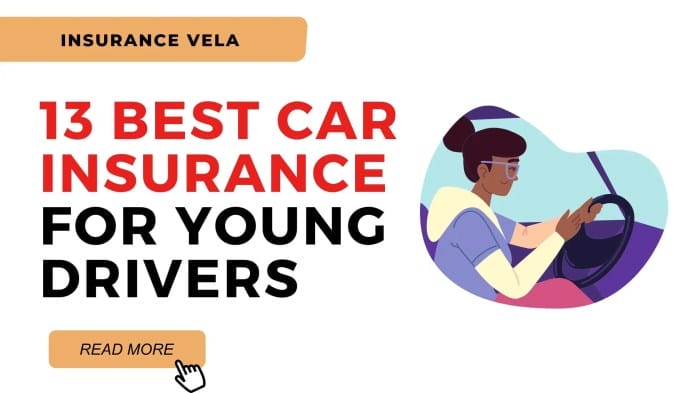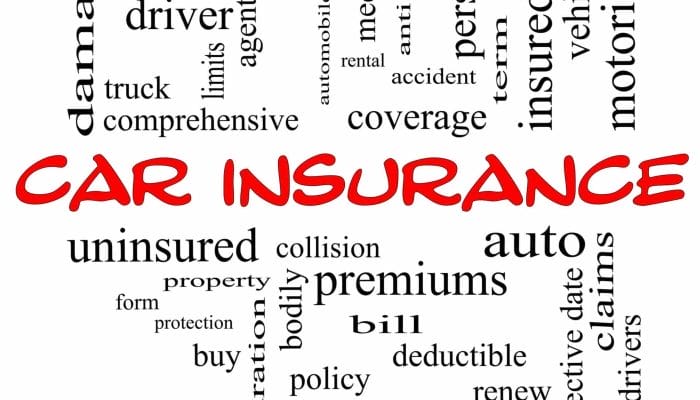For young drivers, securing affordable car insurance can be a daunting task. With insurance rates often skewed against them, it’s essential to understand the factors that influence premiums and explore strategies to minimize costs. This guide delves into the intricacies of car insurance for young drivers, providing practical tips and insights to help them navigate the financial maze and secure the best possible coverage at an attainable price.
The rising cost of car insurance for young drivers is a pressing concern, with statistics indicating a significant financial burden on this demographic. Understanding the factors that determine premiums, such as age, driving experience, vehicle type, and location, is crucial for making informed decisions that can lead to lower rates.
Adopting safe driving habits, selecting a vehicle with lower insurance costs, and taking advantage of discounts and savings opportunities are key strategies to minimize expenses.
Introduction

Young drivers are facing an uphill battle when it comes to car insurance costs. According to a recent study, the average annual premium for a 16-year-old driver is $1,732, which is more than double the rate paid by a 30-year-old driver.
This financial burden can be a significant obstacle for young people who are just starting out in life and may be struggling to make ends meet.
There are a number of factors that contribute to the high cost of car insurance for young drivers. One reason is that they are statistically more likely to be involved in accidents. According to the National Highway Traffic Safety Administration (NHTSA), drivers between the ages of 16 and 19 are three times more likely to be involved in a fatal car crash than drivers who are 20 years old or older.
Contributing Factors
- Age and Experience: Younger drivers have less experience behind the wheel, making them more prone to accidents.
- Risky Driving Behavior: Young drivers are more likely to engage in risky behaviors, such as speeding and distracted driving.
- Higher Claims Frequency: Statistically, young drivers file more claims compared to older drivers.
- Vehicle Type: Young drivers often choose vehicles that are more expensive to insure, such as sports cars or high-performance vehicles.
- Location: Insurance rates can vary significantly depending on the geographic area where the young driver resides.
Understanding Insurance Premiums

Understanding the factors that determine car insurance premiums for young drivers is crucial for making informed decisions and securing affordable coverage. Several key aspects play a significant role in calculating these premiums, including age, driving experience, vehicle type, and location.
Age and Driving Experience
Age and driving experience are two of the most influential factors in determining insurance premiums for young drivers. Statistically, younger drivers have a higher risk of accidents due to lack of experience and maturity behind the wheel. As a result, they often face higher premiums compared to older drivers with more experience.
The number of years of driving experience also plays a role, with drivers who have been on the road for a longer period generally benefiting from lower premiums.
Vehicle Type
The type of vehicle a young driver operates can also impact their insurance premiums. Generally, sports cars, high-performance vehicles, and luxury cars are associated with higher premiums due to their increased risk of accidents and repair costs. Conversely, smaller, safer, and more fuel-efficient vehicles typically carry lower premiums.
Location
The location where a young driver resides can also affect their insurance premiums. Areas with higher rates of accidents, traffic congestion, and crime tend to have higher insurance premiums. Additionally, states with no-fault insurance laws may have different premium structures compared to states with traditional fault-based insurance systems.
Safe Driving Habits
Adopting safe driving practices can significantly impact your insurance premiums. By demonstrating responsible behavior behind the wheel, you can lower your risk profile and potentially qualify for lower rates.
Here are some key safe driving habits that young drivers can incorporate into their routine to improve their driving record and potentially reduce their insurance costs:
Obey Speed Limits
Speeding is one of the most common traffic violations among young drivers and a major contributing factor to accidents. By adhering to speed limits, you reduce the risk of getting a ticket and causing an accident, both of which can lead to higher insurance premiums.
Avoid Distractions
Distracted driving is a serious problem that can have severe consequences. Avoid using cell phones, texting, eating, or engaging in other activities while driving. Keep your focus on the road and your hands on the wheel to minimize distractions and maintain control of your vehicle.
Maintain a Clean Driving Record
A clean driving record is essential for obtaining affordable insurance rates. Avoid traffic violations, such as speeding, reckless driving, and DUI/DWI offenses, as these can significantly increase your insurance premiums. If you do receive a traffic citation, promptly address it by paying the fine or attending traffic school to minimize its impact on your insurance.
Vehicle Selection

The type of car you drive can significantly impact your insurance premiums. Insurers consider various factors, such as the vehicle’s safety features, repair costs, and theft rate, when determining rates.
Opting for a vehicle with a lower insurance cost can save you money on your insurance premiums. Here are some tips for choosing a car with lower insurance costs:
Safety Features
Vehicles with advanced safety features, such as airbags, anti-lock brakes, and electronic stability control, are typically associated with lower insurance rates. These features can help prevent accidents and reduce the severity of crashes, resulting in fewer claims and lower insurance costs for drivers.
Repair Costs
Vehicles with lower repair costs are also more affordable to insure. Insurers consider the cost of parts and labor when determining premiums, so choosing a vehicle with readily available and affordable parts can help you save money on your insurance.
Theft Rate
Vehicles with a higher theft rate are more likely to be stolen, which can lead to higher insurance premiums. Research the theft rates of different vehicles before making a purchase to ensure you choose a model that is less likely to be targeted by thieves.
Discounts and Savings

Many insurance providers offer discounts and savings opportunities specifically tailored for young drivers, making it possible to secure affordable coverage. These discounts can significantly reduce premiums, making it easier for young drivers to obtain comprehensive insurance protection.
Good Student Discounts
Insurance companies often provide discounts to young drivers who maintain good academic standing. This discount can be a significant incentive for young drivers to excel in their studies and encourage responsible behavior.
Multi-Car Policies
If you or your family owns multiple vehicles, you may be eligible for a multi-car discount. This discount is offered by many insurance companies and can result in substantial savings on your car insurance premiums.
Usage-Based Insurance Programs
Usage-based insurance programs, also known as telematics programs, track your driving habits and reward you for safe driving. These programs can provide significant savings for young drivers who demonstrate responsible driving behavior.
Insurance Comparison Shopping

Navigating the world of car insurance can be daunting, especially for young drivers who often face higher premiums. Insurance comparison shopping is a crucial step in securing affordable coverage without compromising on quality. By comparing quotes from multiple providers, you can find the best rates and coverage options tailored to your needs and budget.
Research and Information Gathering
Before embarking on your comparison journey, it’s essential to gather the necessary information to obtain accurate quotes. This includes your personal details, driving history, vehicle information, and desired coverage levels. Make sure you have a clear understanding of your insurance needs and preferences, including the types of coverage you want (e.g.,
liability, collision, comprehensive) and the coverage limits that suit your risk tolerance.
Online Comparison Tools
Numerous online comparison tools and websites allow you to compare car insurance quotes from various providers simultaneously. These platforms typically require you to input your information once, and they generate quotes from multiple insurers. This saves you the hassle of contacting each insurer individually and simplifies the comparison process.
Contacting Insurance Providers Directly
In addition to online comparison tools, you can also contact insurance providers directly to obtain quotes. This approach may be beneficial if you have specific coverage needs or want to discuss your situation with an insurance representative. Be prepared to provide the same information you would when using an online comparison tool.
Comparing Coverage Options and Premiums
When comparing quotes, pay attention to both the coverage options and the premiums. Ensure that the policies you’re comparing offer the same level of coverage and limits. Compare the premiums, deductibles, and any additional fees or discounts that may apply.
Consider the overall value of the policy, not just the lowest premium, as a comprehensive policy with adequate coverage may be worth the extra cost in the long run.
Customer Service and Reputation
While cost is a significant factor, don’t overlook the importance of customer service and the insurer’s reputation. Read online reviews, talk to friends and family, and consider the insurer’s financial stability and claims handling process. A reputable insurer with excellent customer service can provide peace of mind and ensure a smooth experience in the event of a claim.
Bundling Policies
Bundling car insurance policies for multiple vehicles under one provider offers several advantages, including potential savings, streamlined policy management, and convenience. By insuring multiple vehicles with a single carrier, drivers may qualify for discounts and reduced premiums.
Benefits of Bundling Car Insurance Policies
- Cost Savings: Bundling policies often leads to discounted premiums. Insurance providers may offer lower rates for insuring multiple vehicles under the same policy, recognizing the loyalty and stability of customers who consolidate their insurance needs.
- Convenience: Managing multiple car insurance policies under one provider simplifies the process. Policyholders can easily access and manage all their policies through a single account, making it easier to track coverage, make payments, and file claims.
- Streamlined Claims Process: In the event of an accident or claim, dealing with a single insurance provider can expedite the claims process. Policyholders can expect a more efficient and coordinated response from the insurance company, reducing the hassle and stress associated with multiple claims.
Potential Drawbacks of Bundling Policies
- Limited Insurance Options: Bundling policies with a single provider may limit the options for coverage and customization. Policyholders may have fewer choices in terms of coverage limits, deductibles, and additional features compared to purchasing separate policies from different insurers.
- Higher Premiums for High-Risk Drivers: While bundling policies can lead to savings, drivers with a history of accidents or violations may not benefit from discounted rates. In such cases, separate policies from different providers may offer better premiums.
Raising Deductibles
Deductibles play a crucial role in determining insurance premiums. Understanding how deductibles work and how they affect your premium is essential for finding the right balance between cost and coverage.
A deductible is the amount you pay out of pocket before your insurance coverage kicks in. Higher deductibles typically result in lower premiums, while lower deductibles lead to higher premiums. The reason for this is simple: the higher the deductible, the less risk the insurance company assumes, and thus the lower the premium they charge.
Finding the Right Balance
The key to finding the right balance between cost and coverage is to choose a deductible that you can comfortably afford to pay in the event of an accident or claim. It’s important to consider your financial situation, driving habits, and the value of your vehicle when making this decision.
If you have a good driving record and are confident in your ability to avoid accidents, you may be able to opt for a higher deductible to save money on your premium. However, if you are a new driver or have a history of accidents, a lower deductible may be a better choice to provide you with more comprehensive coverage.
Ultimately, the decision of how much deductible to choose is a personal one. Consider your budget, driving habits, and the value of your vehicle to find the right balance between cost and coverage.
Long-Term Strategies: Building a Positive Driving History

Maintaining a positive driving history is crucial for young drivers seeking affordable car insurance. A clean driving record, free of accidents, violations, and moving infractions, can lead to significant savings on insurance premiums.
Insurance companies view drivers with a history of safe driving as lower-risk individuals, making them eligible for lower rates. Conversely, drivers with a history of accidents and violations are considered high-risk and face higher premiums.
Safe Driving Practices
- Obey Speed Limits: Adhere to posted speed limits to avoid speeding tickets and potential accidents.
- Avoid Distractions: Minimize distractions while driving, such as texting, talking on the phone, or eating, to reduce the risk of accidents.
- Use Defensive Driving Techniques: Be aware of your surroundings and anticipate potential hazards to avoid collisions.
- Complete Defensive Driving Courses: Enroll in defensive driving courses to learn safe driving techniques and improve your driving record.
Avoid Accidents and Violations
- Be Cautious in High-Risk Situations: Exercise extra caution in high-risk driving conditions, such as bad weather, heavy traffic, or nighttime driving.
- Maintain Vehicle Safety: Keep your vehicle in good condition with regular maintenance and repairs to prevent breakdowns and accidents.
- Avoid Driving Under the Influence: Never drive under the influence of alcohol or drugs, as it significantly increases the risk of accidents.
Positive Driving History Rewards
- Lower Insurance Premiums: A clean driving record can lead to lower insurance premiums, saving you money over time.
- Increased Coverage Options: Drivers with a positive driving history may be eligible for additional coverage options and discounts.
- Improved Reputation: A clean driving record reflects responsibility and can enhance your reputation with potential employers or landlords.
Additional Resources and Support

Finding affordable car insurance as a young driver can be challenging, but there are resources and organizations dedicated to helping you navigate this process and secure coverage that fits your budget.
Online Resources and Tools
Numerous websites and online resources provide information, tools, and guidance to help young drivers understand car insurance and find affordable options. These resources can include:
Insurance comparison websites
These websites allow you to compare quotes from multiple insurance companies, making it easy to find the best deal.
Insurance calculators
These tools help you estimate the cost of car insurance based on your personal information and driving history.
State insurance departments
Each state has an insurance department that regulates insurance companies and provides information and resources to consumers.
Government and Non-Profit Organizations
Several government agencies and non-profit organizations offer assistance to young drivers seeking affordable car insurance. These organizations can provide information, guidance, and even financial assistance to help you get the coverage you need.
National Association of Insurance Commissioners (NAIC)
The NAIC is a non-profit organization that represents state insurance regulators. They provide information and resources to consumers on a variety of insurance topics, including car insurance.
Consumer Federation of America (CFA)
The CFA is a non-profit organization that advocates for consumer rights. They provide information and resources on a variety of consumer issues, including car insurance.
Insurance Information Institute (III)
The III is a non-profit organization that provides information and resources on insurance. They offer a variety of resources on car insurance, including tips for young drivers.
Final Thoughts

Navigating the complexities of car insurance for young drivers requires a proactive approach, combining knowledge, responsible driving practices, and a keen eye for cost-saving opportunities. By understanding the factors that influence premiums, young drivers can make informed decisions that lead to lower rates.
Embracing safe driving habits, selecting a suitable vehicle, and exploring discounts and savings options can significantly reduce insurance costs. Building a positive driving history over time is essential for long-term savings and securing affordable coverage. With the right strategies and a commitment to safe driving, young drivers can navigate the financial maze of car insurance and find the best coverage at a price that fits their budget.
Frequently Asked Questions
What are some additional tips for young drivers to save money on car insurance?
Enrolling in defensive driving courses and maintaining a good academic record can lead to discounts on insurance premiums.
How can young drivers find the best car insurance rates?
Comparison shopping among multiple insurance providers is essential for finding the most competitive rates. Online comparison tools and independent insurance agents can help young drivers obtain accurate quotes and compare coverage options.
What are the benefits of bundling car insurance policies?
Bundling car insurance policies for multiple vehicles under one provider can result in significant savings. Additionally, bundling home and auto insurance policies with the same provider often leads to further discounts.
How can young drivers raise their deductibles to lower their premiums?
Increasing the deductible on a car insurance policy can lead to lower premiums. However, it’s important to strike a balance between a higher deductible and the ability to cover out-of-pocket expenses in the event of an accident.
Where can young drivers find reputable resources and organizations that provide assistance with affordable car insurance?
Numerous reputable resources and organizations offer guidance and support to young drivers seeking affordable car insurance. The National Association of Insurance Commissioners (NAIC) and the Insurance Information Institute (III) provide valuable information and resources.



